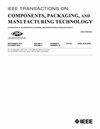利用晶体管级粒度的自适应功率密度采样进行片上热预测
IF 2.3
3区 工程技术
Q2 ENGINEERING, ELECTRICAL & ELECTRONIC
IEEE Transactions on Components, Packaging and Manufacturing Technology
Pub Date : 2024-08-01
DOI:10.1109/TCPMT.2024.3436595
引用次数: 0
摘要
随着芯片规模的迅速扩大,当今的高性能集成电路正面临着日益复杂的热管理挑战。在全芯片热分析过程中,要获得足够精细的温度分布往往非常耗时。在本文中,我们提出了一种基于自适应功率密度采样技术的新型高效片上热预测方法。新方法包括几个步骤。首先,根据布局上的功率密度采样技术采用分区策略,每个采样点对应一个不同的子区域。通过分析每个子区域内标准单元的功率信息,我们生成了基于瓦片的功率密度图(PDM)。随后,对 PDM 应用 Sobel 卷积、阈值滤波、K-means 聚类和自适应功率密度采样算法,以识别布局内的关键子区域 (CSA),并确保这些区域的温度预测精度。最后,通过对子区域进行基于并行有限元法 (FEM) 的热模拟,我们有效地提取了芯片的临界温度信息(临界温度信息)。这包括识别具有最高平均温度(Tavg)的子区域、精确定位峰值温度(Tpeak)出现的坐标,以及突出显示具有显著温度梯度(Tgrad)的区域。我们的方法不仅能获得精确的温度结果,误差范围约为 4%,而且在计算效率方面优于传统的有限元全芯片仿真,同时还能提供精细的芯片热图。本文章由计算机程序翻译,如有差异,请以英文原文为准。
Self-Adapting Power Density Sampling for On-Chip Thermal Prediction With Transistor-Level Granularity
With the rapid increase in chip scale, today’s high-performance integrated circuits are facing increasingly complex thermal management challenges. It is often time-consuming to obtain a sufficiently fine-grained temperature distribution during full-chip thermal analysis. In this article, we propose a novel and efficient on-chip thermal prediction method based on a self-adapting power density sampling technique. The new method consists of a few steps. First, a partitioning strategy is employed based on the power density sampling technique on the layout, where each sample point corresponds to a distinct subregion. Analyzing the power information of standard cells within each subregion, we generate a tile-based power density map (PDM). Subsequently, the Sobel convolution, threshold filtering, K-means clustering, and self-adapting power density sampling algorithms are applied to the PDM to identify critical subareas (CSAs) within the layout and ensure the precision of temperature predictions in these areas. Finally, by conducting parallel finite element method (FEM) based thermal simulations on subregions, we efficiently extract critical temperature information (critical T info.) for the chip. This encompasses identifying the subregions with the highest average temperature (Tavg), pinpointing the coordinates of peak temperature (Tpeak) occurrences, and highlighting areas with notable temperature gradients (Tgrad). Our approach not only achieves precise temperature results with an error margin of about 4% but also outperforms traditional FEM full-chip simulations in computational efficiency while providing a fine-grained thermal map of the chip.
求助全文
通过发布文献求助,成功后即可免费获取论文全文。
去求助
来源期刊

IEEE Transactions on Components, Packaging and Manufacturing Technology
ENGINEERING, MANUFACTURING-ENGINEERING, ELECTRICAL & ELECTRONIC
CiteScore
4.70
自引率
13.60%
发文量
203
审稿时长
3 months
期刊介绍:
IEEE Transactions on Components, Packaging, and Manufacturing Technology publishes research and application articles on modeling, design, building blocks, technical infrastructure, and analysis underpinning electronic, photonic and MEMS packaging, in addition to new developments in passive components, electrical contacts and connectors, thermal management, and device reliability; as well as the manufacture of electronics parts and assemblies, with broad coverage of design, factory modeling, assembly methods, quality, product robustness, and design-for-environment.
 求助内容:
求助内容: 应助结果提醒方式:
应助结果提醒方式:


